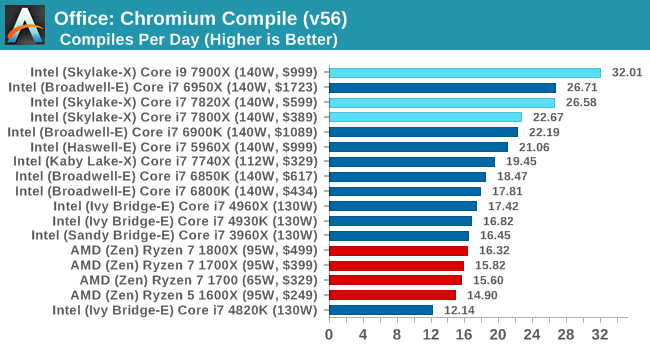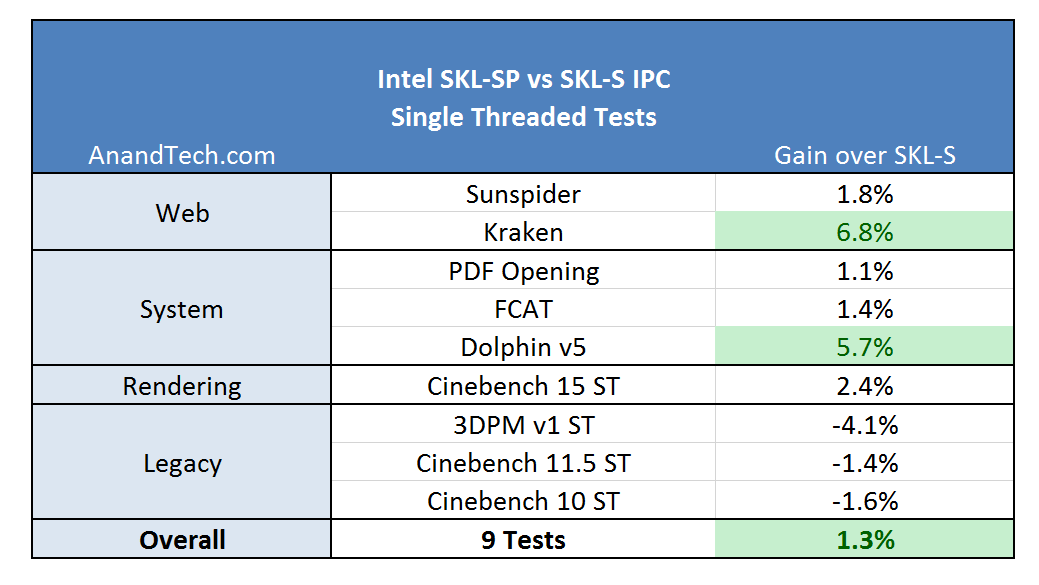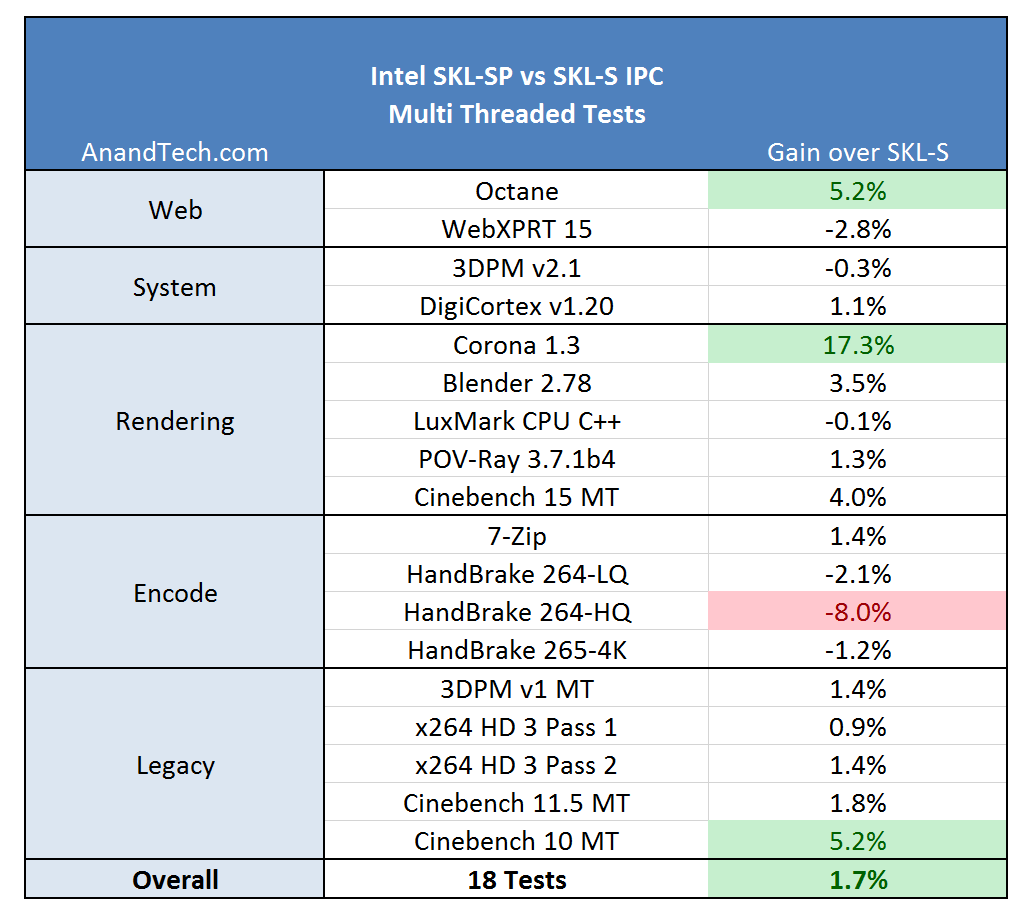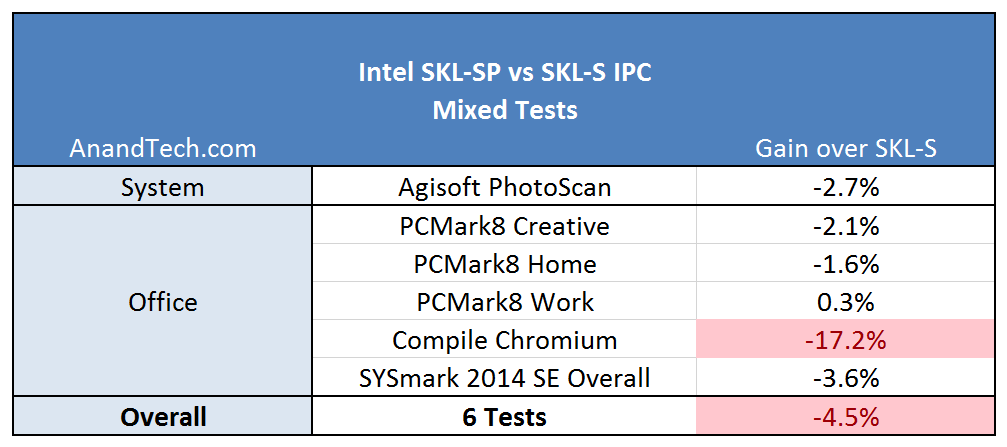The Intel Skylake-X Review: Core i9 7900X, i7 7820X and i7 7800X Tested
by Ian Cutress on June 19, 2017 9:01 AM ESTComparing Skylake-S and Skylake-X/SP Performance Clock-for-Clock
If you’ve read through the full review up to this point (and kudos), there should be three things that stick in the back of your mind about the new Skylake-SP cores: Cache, Mesh and AVX512. These are the three main features that separate the consumer grade Skylake-S core from this new core, and all three can have an impact in clock-for-clock performance. Even though the Skylake-S and the Skylake-SP are not competing in the same markets, it is still poignant to gather how much the changes affect the regular benchmark suite.
For this test, we took the Skylake-S based Core i5-6600 and the Skylake-SP based Core i9-7900X and ran them both with only 4 cores, no hyperthreading, and 3 GHz on all cores with no Turbo active. Both CPUs were run in high performance modes in the OS to restrict any time-to-idle, so it is worth noting here that we are not measuring power. This is just raw throughput.
Both of these cores support different DRAM frequencies, however: the i5-6600 lists DDR4-2133 as its maximum supported frequency, whereas the i9-7900X will run at DDR4-2400 at 2DPC. I queried a few colleagues as to what I should do here – technically the memory support is an extended element of the microarchitecture, and the caches/uncore/untile will be running at different frequencies, so how much of the system support should be chipped away for parity. The general consensus was to test with the supported frequencies, given this is how the parts ship.
For this analysis, each test was broken down in two ways: what sort of benchmark (single thread, multi-thread, mixed) and what category of benchmark (web, office, encode).
For the single threaded tests, results were generally positive. Kraken enjoyed the L2, and Dolphin emulation had a good gain as well. The legacy tests did not fair that great: 3DPM v1 has false sharing, which is likely taking a hit due to the increased L2 latency.
On the multithreaded tests, the big winner here was Corona. Corona is a high-performance renderer for Autodesk 3ds Max, showing that the larger L2 does a good job with its code base. The step back was in Handbrake – our testing does not implement any AVX512 code, but the L3 victim cache might be at play here over the L3 inclusive cache in SKL-S.
The mixed results are surprising: these tests vary with ST and MT parts to their computation, some being cache sensitive as well. The big outlier here is the compile test, indicating that the Skylake-SP might not be (clock for clock) a great compilation core. This is a result we can trace back to the L3 again, being a smaller non-inclusive cache. In our results database, we can see similar results when comparing a Ryzen 7 1700X, an 8-core 95W CPU with 16MB of L3 victim cache, is easily beaten by a Core i7-7700T, with 4 cores at 35W but has 8MB of inclusive L3 cache.
If we treat each of these tests with equal weighting, the overall result will offer a +0.5% gain to the new Skylake-SP core, which is with the margin of error. Nothing too much to be concerned about for most users (except perhaps people who compile all day), although again, these two cores are not in chips that directly compete. The 10-core SKL-SP chip still does the business on compiling:

If all these changes (minus AVX512) offer a +0.5% gain over the standard Skylake-S core, then one question worth asking is what was the point? The answer is usually simple, and I suspect involves scaling (moving to chips with more cores), but also customer related. Intel’s big money comes from the enterprise, and no doubt some of Intel’s internal metrics (as well as customer requests) point to a sizeable chunk of enterprise compute being L2 size limited. I’ll be looking forward to Johan’s review on the enterprise side when the time comes.













264 Comments
View All Comments
zlandar - Monday, June 19, 2017 - link
Glad AMD is lighting a fire under Intel's complacent butt.SaolDan - Monday, June 19, 2017 - link
Can these chips be overclocked? If so can we get some charts? This is my go to site for tech.Despoiler - Monday, June 19, 2017 - link
According to Tom's these things are dogs. AIOs can only handle stock frequencies and Prime95 runs.http://www.tomshardware.com/reviews/intel-core-i9-...
Archie2085 - Monday, June 19, 2017 - link
@ Ryan @ IanHow Come no one is talking about the Power Draw or Performance Per Watt per $$. If that is the Metric Looks Like AMD has a winner achieving 80% Results with a 8 Core Processor Against 10 Core Giants Not to mention at a Fraction of Cost
The Release under such a tearing Hurry Definitely looks like a Knee Jerk Reaction of Zen and Impending Release of Thread Ripper...
I would Expect you to Give a proper review of Thread ripper just as you have not Made any Meaningful mention of it in this article even though Performance leaks have started...
Looks More Like a Marketing Article than a Review of Pros and Cons.
BrokenCrayons - Monday, June 19, 2017 - link
What's with the odd capitalizations?FreckledTrout - Monday, June 19, 2017 - link
I'm not sure how much Performance Per Watt comes into play here but it should at least some. Mostly in the workstation and desktop market its price vs performance. The data center CPU's performance per watt is what it is all about and Intel is in for some trouble if this is a trend that continues into the data center CPU's. AMD may really have some pretty good CPU's in thread ripper and EPYC.Archie2085 - Monday, June 19, 2017 - link
HEDT practically is a workstation chip used for workstations. For Freelancers cost Vs extracted value should have a bearing on the choiceFreckledTrout - Monday, June 19, 2017 - link
No argument that is what I was hinting at wen I said price vs performance. The perf vs power draw ins't top of most workstation users lists, it is mostly how much do I pay for this nn percent improvement in rendering times for example. The performance per watt doesn't matter to to many outside of data centers, well it matters to everyone, but to a much larger degree in data centers.GeorgeH - Monday, June 19, 2017 - link
Thanks for the review. I generally enjoy your perspective, and try to remember to support you by using a browser with no ad blocking, but have to say your website is almost unusable using Microsoft Edge because of the ads (on my ultrabook with an i5-5300u). I had to switch to an ad blocking browser mid stream to actually read your content, which isn't good for anyone.Silma - Monday, June 19, 2017 - link
I was disappointed to find no information on overcloackability, or did I read too fast.I would expect a lesser overcloackability since the frequency & TDP are already pushed.
I'd be glad to be proven wrong.